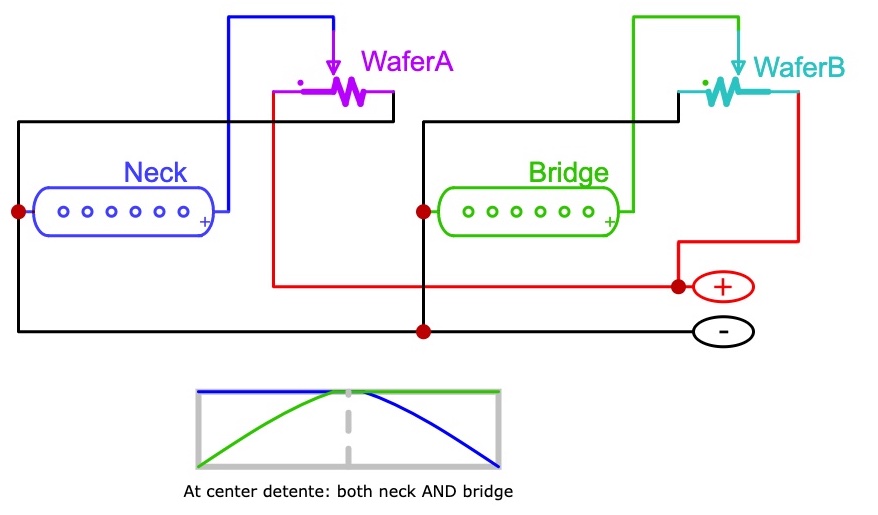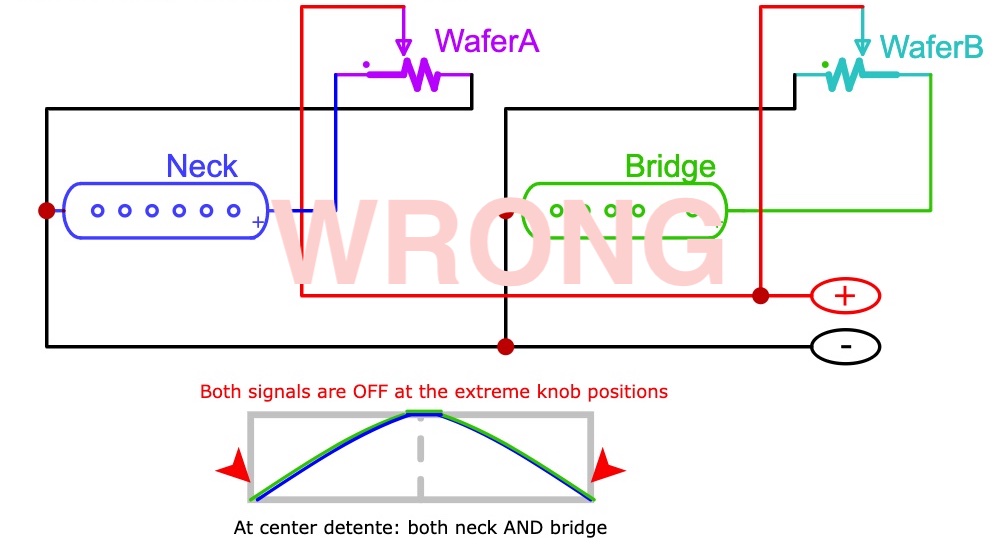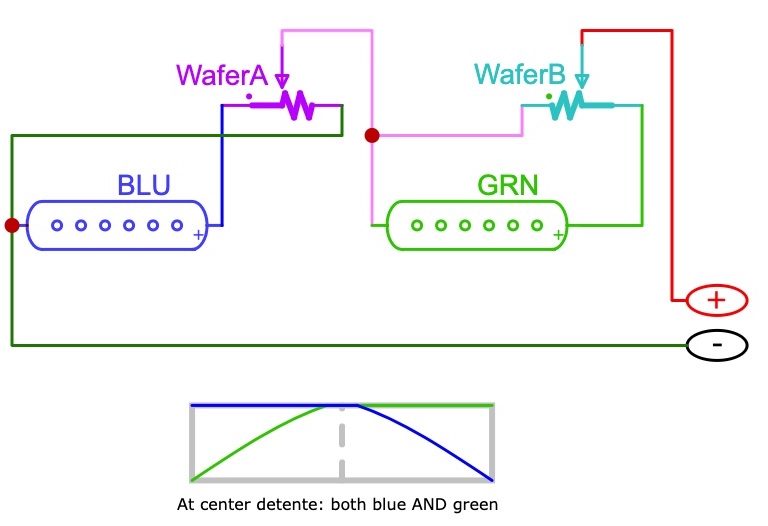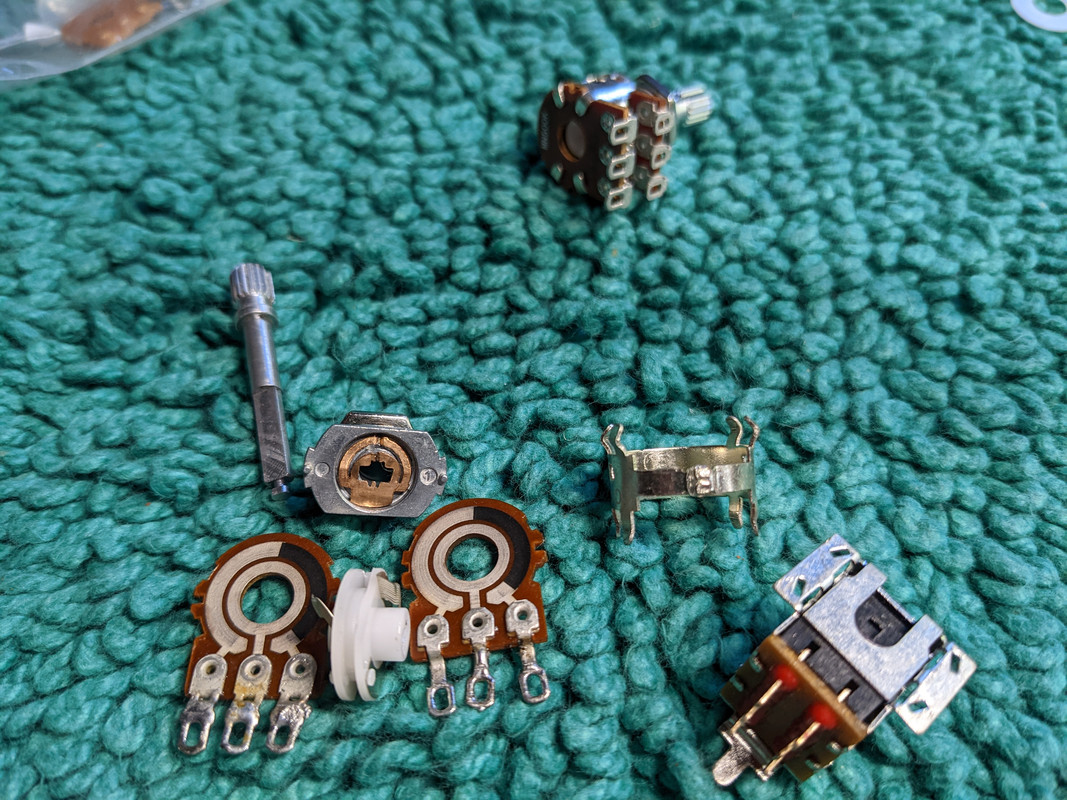|
|
Post by David Mitchell on Dec 6, 2022 13:55:54 GMT -5
Despite all advice to the contrary, I still want to try a blend pot (yes, a Bourns MN blender) in my guitar in place of the standard pickup selector. Up until I tried to make a wiring diagram, I was thinking of it as a dual-gang volume control with a different taper, but after looking at other diagrams for blend pots, I am confused. Why are the inputs for a blender on the center lug? Despite reading Potentiometer orientation and Blend and Pan Pots, I just haven't grasped how these things actually work. Here's an excerpt of the diagram as I have it now: |
|
|
|
Post by newey on Dec 6, 2022 15:37:28 GMT -5
I'll leave it to others to explain the workings of the blend control, but I question whether you would really want to eliminate the pickup selector switch and just have only a blend control. It's easier to flick a switch than to turn a knob, for starters, and one advantage to having the blend is that you can "pre-set" a level of blending for the 2-pickup selections, so if you're using, say, just the bridge pickup for lead stuff, you can easly flick the switch to get your blend with both pickups. You can't do that if the blend is the only control you have.
I think, with a blend pot alone, you'll be constantly monkeying with that control to get what you want. Obviously, everyone's tastes vary and so do playing styles, but I for one could not live without a pickup selector.
|
|
|
|
Post by stevewf on Dec 6, 2022 16:30:42 GMT -5
Hi. Just so happens that I've been poking around with Bourns MN these past few days. Hook up the inputs to the center lugs, just like your wiring diagram, if you want the coils in parallel with each other. But if you want them in serial, the inputs go on outer lugs. So yes, the inputs have to go on the middle lugs for a parallel wiring, in order to avoid a problem that LP players are familiar with: when you turn just one pickup's volume down all the way, it kills the whole signal (regardless of the other pickup's volume position). Here's a schematic of Parallel, which I think agrees with your diagram: PARALLEL
Here's a parallel schematic, incorrectly wired: PARALLEL, WRONG In the "Wrong" schematic, imagine the sweepers having been turned all the way to the right, for example, and look at WaferA, where the red wire has become connected to the ground. The red wire, at its other end, is also permanently connected to the output, so now we have output being completely shorted to ground. No sound! Same thing happens when the knob's twisted to the left, with WaferB. It's like having a volume knob with "Full" being at the center (and worse, having half the nominal resistance of the pot - if you have a Bourns 250K MN and you wire it this way, you actually end up with a 125K, center-full volume pot). Usually not intended, but, hey - no rules! And by the way, here's a schematic of Serial: SERIAL (Substitute your pickups for BLU and GRN) In the Serial setup, unlike for parallel, the pickup inputs are connected to outer lugs, and the output comes from the center lugs (serially, I mean; the final output comes from only one of the center lugs, of course). ChrisK provided a schematic for switching between parallel and serial by using a 2P2T switch. |
|
|
|
Post by stevewf on Dec 6, 2022 17:26:03 GMT -5
Oh, and maybe there's some of the physical characteristics of the Bourns MN that are confusing. I was modding one of them, and here's what the pieces looked like: 
Note the two wafers with their traces visible. You can see that the trace on an MN wafer is not homogenous - it's half silver and half black. Actually, it's not precisely 50-50; the silver part includes the midpoint, where the detente is. So on both wafers, when the knob is at the midpoint detente, the sweepers are contacting the silver parts of their traces. The silver half is non-resistive - it will pass all of the signal through. The black part of the trace is resistive, like what's found on a normal pot (except that on a normal pot, the resistive track accounts for the entire trace). So as the knob's turned, only half of the rotation will cause a change in signal. This applies to each wafer, and since the wafers are mirror-positioned, so are the traces. This means that one half of rotation (say 0-5) will affect one of the wafers, whereas 5-10 affects the other wafer. So, yes there are two separate volume circuits, but each one works on only half of the rotation. |
|
|
|
Post by David Mitchell on Dec 12, 2022 21:09:44 GMT -5
I'll leave it to others to explain the workings of the blend control, but I question whether you would really want to eliminate the pickup selector switch and just have only a blend control. It's easier to flick a switch than to turn a knob, for starters, and one advantage to having the blend is that you can "pre-set" a level of blending for the 2-pickup selections, so if you're using, say, just the bridge pickup for lead stuff, you can easly flick the switch to get your blend with both pickups. You can't do that if the blend is the only control you have. I think, with a blend pot alone, you'll be constantly monkeying with that control to get what you want. Obviously, everyone's tastes vary and so do playing styles, but I for one could not live without a pickup selector. , you would suggest having both the three-way selector and a blend knob (if I want a blend control)? I'm not currently playing in public, but when I did I would usually only switch pickups between songs. For some reason, I really dislike how the selector feels (maybe I just need a different one?), and how it goes "clonk" when I switch positions. That's why I'm thinking I might get along better with a blend knob. Also, I am curious about trying to pull some of those in-between-in-between sounds out of it, even if it is fiddly. But as the proverb says, "Fools think their own way is right, but the wise listen to advice."
stevewf, I was looking at your thread before I posted mine, but yours was well over my head. Thanks for sharing all that information about them! I'll have to get back to you later after I have more time to puzzle through it.... |
|
|
|
Post by newey on Dec 13, 2022 22:49:12 GMT -5
It's nice to have the option to use the switch, and it allows you to use the blender as a sort of "preset" when you go to both pickups. But, hey, to each their own. Jazz Bass players seem to get along fine without a pickup switches. But they're bass players, of course . . .  Your selector should not go "clonk" when switched. That, plus a lousy switch feel, would have me looking for a replacement for sure. But the "clonk" could also be due to something as simple as a need to ground the case of the switch. |
|
|
|
Post by David Mitchell on Dec 19, 2022 21:17:48 GMT -5
It's nice to have the option to use the switch, and it allows you to use the blender as a sort of "preset" when you go to both pickups. But, hey, to each their own. Jazz Bass players seem to get along fine without a pickup switches. But they're bass players, of course . . .  Your selector should not go "clonk" when switched. That, plus a lousy switch feel, would have me looking for a replacement for sure. But the "clonk" could also be due to something as simple as a need to ground the case of the switch. Heh. I have only three control positions to work with on this guitar — until I go and drill more, anyway — so I'm thinking about how to get the most out of just three knobs or switches. To be clear, the "clonk" is (mostly?) acoustic. The switch is pretty stiff and the guitar practically rings when I use it. Maybe I should invest $20-30 in a Switchcraft pickup selector? |
|
|
|
Post by stevewf on Dec 19, 2022 22:52:28 GMT -5
stevewf, I was looking at your thread before I posted mine, but yours was well over my head. Thanks for sharing all that information about them! I'll have to get back to you later after I have more time to puzzle through it.... I think I tend to write badly. Too wordy. But anyway, that aim of our two threads is different, so I can see as that other thread wouldn't necessarily serve your needs. Suffice to say that my "AND" function matches most closely what I think you're after. Since then, I've also learned a bit more about "loading". Loading coils, that is. The blend pot has two voltage dividers, each of which load the circuit. That means that in a single knob, the blend pot(s) will load like two separate volume controls. In general, that'll lead to less treble in the final output. Just a reminding caution. |
|
|
|
Post by speciallittleguy on Dec 27, 2022 18:09:21 GMT -5
Hello! I'm new to GN2 but I love how active the discussions are here. I read through the rules but didn't see anything disallowing cross posting from other forums. If this isn't allowed please let me know and I'll remove the link. Hey! I just spent my Christmas weekend with a cold writing a rather thorough discussion on blender pots, from "what is a potentiometer" all the way to some full guitar mod circuits. www.strat-talk.com/threads/blender-pots-intro-and-advanced-topics.595265/I see that you're curious about parallel and serial wiring- this is all discussed in decent detail. Blending in serial certainly does not "have" to connect the pickup positive with an outer lug. |
|
|
|
Post by David Mitchell on Mar 2, 2023 21:08:18 GMT -5
Still trying to get back into this project! Things have been crazy lately (mainly, a lot of sickness). Just wanted to follow up on the last couple of posts. Since then, I've also learned a bit more about "loading". Loading coils, that is. The blend pot has two voltage dividers, each of which load the circuit. That means that in a single knob, the blend pot(s) will load like two separate volume controls. In general, that'll lead to less treble in the final output. Just a reminding caution. Thanks for the caution, stevewf. I'm planning to use some sort of no-load tone control (if I use one at all), and I've also bought a Redeemer buffer to mitigate the treble losses from the blend pot (I realize that the added load by itself changes the sound). I've just been staring at your diagrams for a bit. I'll figure it out eventually! Hello! I'm new to GN2 but I love how active the discussions are here. I read through the rules but didn't see anything disallowing cross posting from other forums. If this isn't allowed please let me know and I'll remove the link. Hey! I just spent my Christmas weekend with a cold writing a rather thorough discussion on blender pots, from "what is a potentiometer" all the way to some full guitar mod circuits. www.strat-talk.com/threads/blender-pots-intro-and-advanced-topics.595265/I see that you're curious about parallel and serial wiring- this is all discussed in decent detail. Blending in serial certainly does not "have" to connect the pickup positive with an outer lug. Thanks for sharing, speciallittleguy! I'm looking through your thread as well. |
|
|
|
Post by gckelloch on Mar 3, 2023 0:34:16 GMT -5
If you leave each 3rd lug of the MN blend pot open (ungrounded) the pot resistance won't load the circuit at all when the blend is at center. I don't know if it loads when turned either way, but you would need a pickup selector to fully remove either pickup from the signal. You could then skip the buffer and use a standard tone pot.
I'd wire it so the blend is only active in the middle switch pos, and it may be more useful to have the tone knob only on the 1 & 3 pos.
Also, consider a phase switch on one of the pickups. It offers very useful brighter sounding blend options with ample note fundamentals when the blend is not right near the center.
|
|